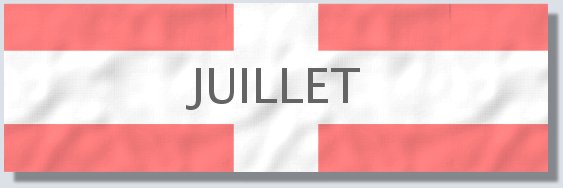|
Now that I’d had some time to unpack
and get my bearings, I took the opportunity to do some roaming.
Though somewhat hot, the weather was good with a long stretch
of sunny days on the horizon. The latter half of the month
was to be spent in Italy with my wife and parents, so I
wanted to squeeze in a few things before then.
|
|
|
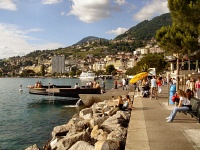
Montreux and the Lake Geneva shoreline.
|
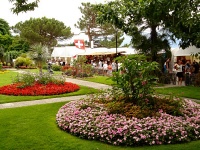
The promenade rife with stalls and
fans .
|
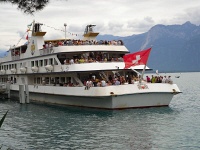
The salsa music boat readies to disembark.
|
|
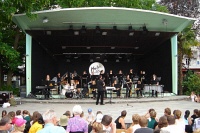
An Australian high shool jazz band.
|
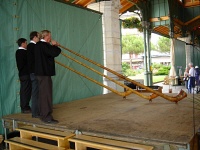
A local horn section entertains diners.
|
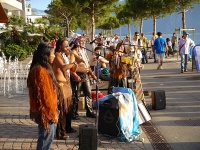
The US was also represented.
|
|
|
For a few weeks each summer, a small
town on the Swiss Riviera becomes a veritable hub of music,
music fans, and musicians. I couldn’t very well be this
close without seeing what the Montreux Jazz Festival was
all about. I’ve been to a fair share of concerts and even
a few music festivals, but the Montreux festival was very
different from anything I had experienced before. It's not
just a jazz festival. The fans and the music covered the
whole spectrum – from jazz to classical to rock to country
to folk to pop to rap. Some fans were dressed in tuxedos,
some in tie-dye and dreadlocks. The promenade along Lake
Geneva was abuzz with stands selling crafts, wares, and
food. Local delicacies like rösti and fries
with raclette as well as dishes from all around the
world. It was a tough choice. Similarly, there were musicians
playing everywhere – some scheduled, some not. For those
fans without tickets, there were musical boat excursions
out onto the lake.
Montreux has been internationally
renowned for many years. Notables such as Byron and Shelley,
Tolstoy, Hans Christian Anderson, and Stravinsky all spent
significant time there. Charlie Chaplin lived in the neighboring
town of Vevey (also the headquarters of Nestlé).
Freddie Mercury lived in Montreux until his death in 1991.
The festival itself was the brainchild of Claude Nobs, who
as a member of the Montreux tourist office traveled to New
York in 1966 to brashly meet with Nesuhi Ertegun, the head
of Atlantic Records which managed some of Nobs' favorite
artists. Ertegun knew Montreux well, as his father was the Turkish
ambassador to Switzerland for a number of years, and was
intrigued by the idea. The inaugural Montreux Jazz Festival
in 1967 featured seven acts, all at the Casino Theater.
In 1973, Nobs became director of the Warner, Elektra, and
Atlantic Group in Switzerland, ensuring a steady stream
of top-flight performers to the festival. Over time, it
has increased in size and attendance to the point where
this year’s festival, the 39th held, has more than 140 acts.
There are essentially four main venues that are used over
the 3 weeks of the festival – the Auditorium Stravinsky,
Miles Davis Hall, the Casino Barrière, and the Montreux
Jazz Café. Other impromptu stages are set up to host
free concerts.
Of course, it’s hard not to walk
around Montreux without having the famed Deep Purple tune
playing in the back of your mind. In 1971, Deep Purple went
to record their album Machine Head in Montreux. They planned
to use the Casino Theater to record, but on December 4,
the venue caught fire when a fan shot off a flare during
a Frank Zappa and the Mothers of Invention concert. The
blaze and ensuing events (including funky Claude pulling
kids off the ground) inspired Ian Gillan and Roger Glover
to pen the classic Smoke on the Water. Ironically,
the band was hesitant to include it on the album because
they feared it would be considered a drug song.
On my way to France, I had picked
up a schedule in Geneva to decide on a weekend to go. When
compared to past lineups, this year’s was far from stellar.
The fact that Live 8 was held at the same time certainly
had an impact. Nevertheless, the weekend I chose featured
the Wattstax Revue with Booker T & the MGs, Billy Preston,
and Isaac Hayes in the Auditorium Stravinsky. I was pretty
psyched to see Booker T & the MGs since they were legendary
in the soul world, having backed almost everyone on the
Stax label including Wilson Picket and Otis Redding. They
hadn’t played together in 17 years. I was luke warm on Billy
Preston and Isaac Hayes but had never seen either of them.
The show was to begin at 8:30pm and I figured I would be
out of there around 11pm and on my way home to France. What
I didn’t realize is that each artist was going to play 90
min sets, and then play another 45 min together for the
finale. With time between sets to change equipment, the
show finally ended at 2:30am. Let me tell you, the smooth,
stylish sounds of Isaac Hayes in the wee hours of the morning
are pretty hard to take. Nevertheless, it was a fabulous
show and a unique experience. I finally got home at 5:30am.
|
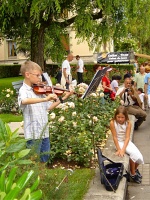
Virtuosos were sprouting up everywhere.
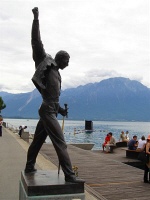
A statue honoring longtime resident
Freddie Mercury.
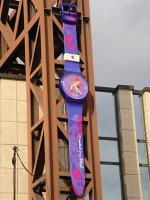
Swatch - an official sponsor of the
jazz festival.
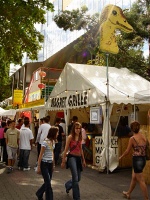
Duck sandwiches on offer.
|
|
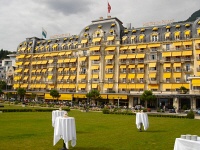
The Palace Hotel - the place to stay.
|
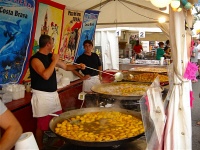
Big food from Spain.
|
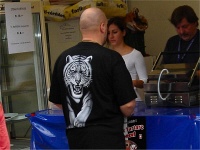
Even the steak tartare guy had business.
|
|
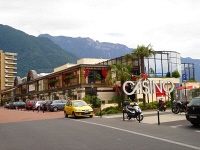
A new casino replaces the one that
burned down in 1971.
|
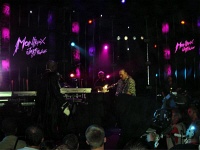
Steve Cropper and Duck Dunn play with
Isaac Hayes for the first time in 40 years.
|
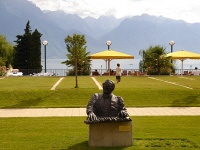
A bust commemorates Ray Charles in
the Palace Hotel's park of monuments.
|
|
|
|
Just beyond Montreux where the passage
between the mountains and Lake Geneva narrows is the picturesque
Château de Chillon. There is evidence that the rock
on which the castle is built was a Roman outpost guarding
the route between Geneva and Italy. The current structure
was built by the Counts of Savoie in the 12th century for
the same purpose. Its literary notoriety stemmed from the
16th century imprisonment of François Bonivard for
promoting reformation. Upon learning of the story during
a visit to the castle and its dungeon, Lord Byron later
wrote poems entitled On the Castle of Chillon (excerpt
below) and The Prisoner of Chillon to honor Bonivard’s
plight.
Chillon! thy prison is a holy
place
And thy sad floor an altar, for ’twas trod,
Until his very steps have left a trace
Worn as if thy cold pavement were
a sod,
By Bonnivard! May none those marks efface!
For they appeal from tyranny to God
|
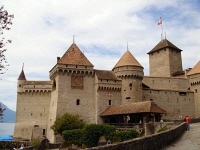
Château de Chillon - a
fortress and residence of the Counts of Savoie.
|
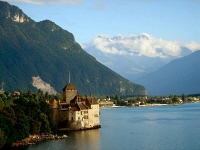
The château guarded the
strategic route between Geneva and Italy.
|
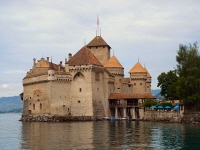
Roman artifacts have been found
on and around the rock on which it's built.
|
|
|
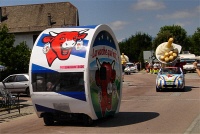
One of my favorite cheeses rolls
by.
|
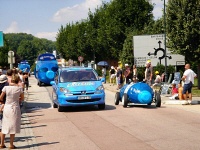
It's the Caravan!
|
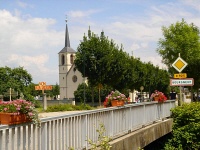
Sleepy Bourgneuf comes alive.
|
|
|
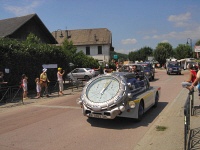
Some were creative.
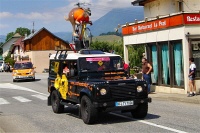
Some came from far away.
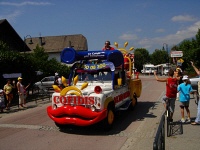
Some made you scratch your head.
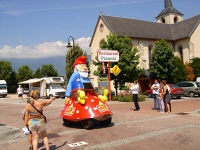
Some weren't even trying.
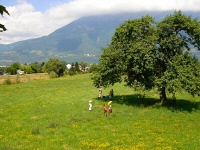
A family seeks shade as they
wait.
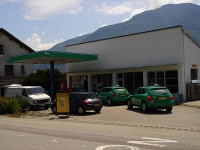
No gas for you.
|
The month of July is always
beset with news on the Tour de France. TV stations
alternate coverage as if in a relay so that every
minute is televised. Websites track progress of each
stage with play-by-play commentary. Knowing that stages
through the Alps are a standard each year, I checked
this year’s route to see how close they would come
to Chambéry. As luck would have it, they were
passing through the town of Bourgneuf only twenty
minutes away. So on a Tuesday morning, I skipped out
of work for "an extended lunch” and drove out
to see the Tour.
An important and celebrated
part of the Tour de France is the Caravan. This essentially
consists of sponsors’ cars, buses, and floats that
precede the cyclists by several hours. Some of the
vehicles are quite clever, but the real appeal is
the cheap pieces of crap which are thrown to the on-lookers.
Just standing there I got two hats, an LED keychain,
and six lariats. I’m not even sure what to do with
one lariat.
After the Caravan comes to
a close, there is a period of nearly an hour in which
the anticipation begins to mount. No one knows exactly
when the leaders will arrive. So you wait and wait.
I had been advised to drive to the mountains because
seeing the racers climb a hill like Courchevel makes
for better spectating. The cyclists are spaced further
apart and move at much slower speeds. Unfortunately,
it being a work day, I really didn’t have that luxury.
The best I could do was to position myself near a
traffic circle which forced the riders to form a single
file as they made the turn. Suddenly, the crowd begins
to stir and people get their cameras ready. False
alarm, it’s just some guy peddling back from the market
with baguettes strapped to his bicycle. More
waiting follows and people begin to try and find shade
from the mid-day sun. Eventually, the crowd slowly
works into a frenzy with shouts of Allez! Allez!,
and suddenly from around the corner comes a handful
of riders – swoosh – and they’re gone. These
are the leaders of the stage, typically a small group
of cyclists who break away from the pack. Then, there’s
more waiting. In this case another twenty minutes
until finally the bulk of the racers or peloton
come shooting by in a rainbow of colors. Bringing
up the rear is the immense entourage of cars carrying
spare bikes, bike parts, mechanics, radio guys, medics,
and various other people vital to the success of their
team. My guess is a ratio of two cars to every rider.
And then, as quickly as it began, it’s all over and
people start going home. So in the end, I stood around
for three and a half hours for about 90 seconds of
Tour de France. At least I still have the memories
of the Caravan – and six lariats.
One last observation: During
the entire event, I was standing across from a gas
station. It so happened that the racers passed through
Bourgneuf during lunchtime, the period between noon
and 2:30 pm that is sacred to all French men, women
and children. The owner of the gas station closed
for lunch as he probably does everyday. In fact, almost
everything in France closes for these two and a half
hours. I even saw a restaurant close during the lunch
hours. Anyway, the owner sat in the office to eat
lunch and no doubt watched the Tour on television.
So here comes the Caravan and the entourage, comprising
hundreds of vehicles, and this guy has a veritable
gold mine on his hands. Cars were pulling into his
station to fuel up, but he wouldn’t open! Even the
hallowed institution that is the Tour de France can’t
persuade a Frenchman to work during his lunch.
|
|
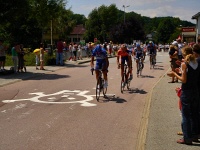
The leaders out front by 20
min.
|
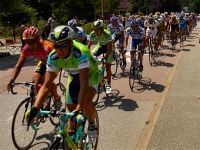
The peloton.
|
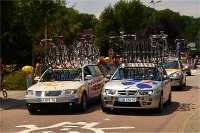
The entourage.
|
|
|
|
My July holiday was slightly
postponed this year, as I had worked on July 4th knowing
that I would have a day off the following week. On
July 14, 1789, a Parisian mob stormed the Bastille
prison, marking the beginning of the French Revolution.
It is regarded as a sort of Independence Day and is
commemorated by a massive parade down the Champs-Elysées
in Paris. My friend believes that to make the parade
look more impressive, some of the soldiers are directed
back to the beginning of the parade route to march
again.
Anyway, since I wasn’t up to
a trip to Paris, I opted to head to Chambéry
for their version. I positioned myself along the parade
route shortly before the 10am start time. Soon, a
small band and some sash-wearing city officials arrived
to officially start the event. Minutes later, singing
in unison, came the famed Chasseurs Alpins (Alpine
Riflemen). Chambéry hosts one of only three
remaining battalions of these mountain warfare specialists.
Armed with mountain boots, woolen socks, signature
white uniforms, and sniper rifles, the Chasseurs Alpins
are experts in mountaineering, climbing and skiing.
They have seen action in both world wars, Indochina,
Tunisia, Algeria, Lebanon and Yugoslavia.
After the Chasseurs Alpins
had passed, I waited another few minutes but saw nothing
coming. I asked a nearby policeman if there was an
alternate parade route that I didn’t know about. He
told me that the parade was over, and everyone was
going home to get ready for lunch. It was 10:20.
In the office the following
day, one of the few people working asked me what I
did during the holiday. I told him about the parade
and that I especially liked the “Chausseurs Alpins”.
Not only were they interesting to see in person, but
I found it intriguing that the French military would
still support such a specialized unit in this age
of tactical weaponry. He stared at me blankly for
a minute or two not knowing what to say until I realized
that I had mispronounced Chasseurs Alpins. For the
last five minutes, I had been going on about how much
I enjoyed the “Alpine shoe salesmen”. Poor guy probably
thought I was nuts.
|
|
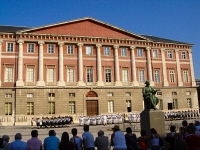
Chasseurs Alpins at the Palais
de Justice.
|
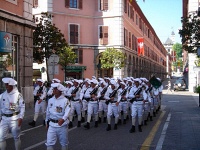
Marching in traditional whites.
|
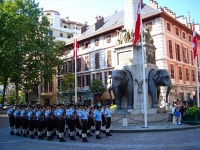
Ready to be dismissed and eat
lunch.
|
|
|
|
